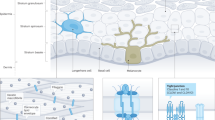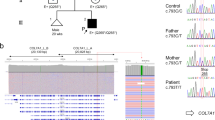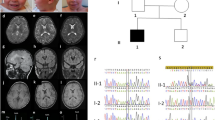Abstract
Autosomal recessive lamellar ichthyosis (ARLI) is a congenital disorder of keratinization, the gene of which has been mapped to chromosome 14q11. This band is also the breakpoint in various chromosomal rearrangements in T cell acute lymphoblastic leukemia (ALL). We describe a patient with ARLI who developed ALL at the age of 2.5 years. High resolution banding showed no abnormality or rearrangement involving chromosome 14. To our knowledge, this is the first description of the occurrence of the two conditions in one patient.
Similar content being viewed by others
Introduction
Autosomal recessive lamellar ichthyosis (ARLI) is a congenital disorder of keratinization (Mendelian Inheritance in Man 242100, MIM, estimated incidence 1:250,000) [1]. The gene for this disease has been mapped to chromosome 14q11 by linkage analysis [2]. Mutations in the keratinocyte transglutaminase gene (TGK) have been identified in families with this disease [3, 4]. Since the TGK gene maps to chromosome 14q11 [5], it is assumed that it is the disease gene in ARLI. The same band, 14q11, is the breakpoint in various chromosomal rearrangements in T cell acute lymphoblastic leukemia (ALL) and the locus for alpha and delta T cell receptor genes [6]. X-linked ichthyosis and ALL have been reported before in one patient [7]. We describe here a patient with ARLI who developed ALL, which to our knowledge has not been reported before. We also discuss the genetic relations of these two conditions and leukemogenesis.
Case Report
A 2.5-year-old female patient was admitted to the Princess Badi’a Teaching Hospital with a 3-day history of right upper quadrant and periumbilical abdominal pain and loss of appetite. There was a prolonged history of difficulty in swallowing. She was born with mild erythroderma and generalized dryness of the skin, which improved with time. She is the second child of distantly related normal parents. Her younger sister aged 1.5 years is healthy, but her 4-year-old sister has a similar skin condition.
On physical examination she had stable vital signs and generalized fine scaling of the skin most pronounced on the trunk. The flexures and face were involved but the palms and soles were spared. She had mild ectropion, slight crumpling of the ears and sparsity of scalp hair. Her teeth and nails were normal. She had obvious abdominal distension with gross hepatosplenomegaly and generalized lymphadenopathy. A chest x-ray did not show any mediastinal mass. Laboratory studies showed Hb: 10 g/dl, ESR 60 mm/h, platelet count: 19 × 109/l, WBC: 6.4 × 109/l with 91% lymphocytes and 9% neutrophils. Bone marrow examination confirmed the diagnosis of ALL (L1/L2 morphology FAB classification). Further identification of the ALL could not be performed at our laboratory. High resolution banding showed no abnormality or rearrangement involving chromosome 14 and in particular band q11.
Light microscopy of a skin biopsy from the trunk showed hyperkeratosis, parakeratosis and acanthosis. Electron microscopy revealed numerous lipid vacuoles in the stratum corneum (fig. 1); these are all features of erythrodermic lamellar ichthyosis.
She was treated according to the UKALL X, standard risk leukemia protocol (arm A) [8] but unfortunately died 2 weeks later of severe chemotherapy-related toxicity.
Discussion
The clinical, histological and ultrastructural features of this patient’s skin are in keeping with the erythrodermic variant of ARLI (synonym: nonbullous congenital ichthyosiform erythroderma). The more severe nonerythrodermic variant characterized by generalized plate-like scales was initially linked to chromosome 14q11 [2]. The TGK gene, which encodes one of the enzymes responsible for cross-linking epidermal proteins during formation of the stratum corneum, maps to 14q11 [5] and subsequently mutations in the TGK gene were identified in families with both variants of ARLI [3, 4].
Chromosomal rearrangements involving 14q11 occur in T cell ALL [6]. On the other hand, T lineage ALL is associated with L1 or L2 morphology of lymphoblasts in similar relative frequencies as B lineage ALL [9]. In our patient, further identification of the leukemia type could not be done at our laboratory, and although no mediastinal mass was present, T cell ALL could still be the diagnosis.
The concomitant occurrence of ARLI and ALL, possibly of T cell origin, in one individual suggests a common causal factor for both conditions. Since high resolution banding did not reveal a deletion of the band 14q11, we think there is either a submicroscopic cryptic deletion involving the two genes or a deletion involving a control element that regulates the expression of both genes. In this family, individuals with the skin disease may be at risk of developing ALL. Although the carriers of ARLI in this family and the other affected sib have not developed any malignancy to date, they should perhaps be observed closely for early diagnosis of such a complication.
Despite modest treatment intensity and the availability of good supportive care, our patient died 2 weeks after induction treatment because of chemotherapy-related toxicity. It is difficult to draw conclusions from a single case report, but this may suggest that our patient had an unusual sensitivity to chemotherapy.
References
Williams ML, Elias PM: Disorders of cornification; in Alper JL (ed): Dermatologic Clinics. Philadelphia, Saunders, 1986, pp 155–178.
Russell LJ, DiGiovanna JJ, Hashem N, Compton JG, Bale SJ: Linkage of autosomal recessive lamellar ichthyosis to chromosome 14q. Am J Hum Genet 1994;55:1146–1152
Huber M, Rettler I, Bernasconi K, Frenk E, Lavrijsen SPM, Ponec M, Bon A, Lautenschlager S, Schorderet DF, Hohl D: Mutations of keratinocyte transglutaminase in lamellar ichthyosis. Science 1995;267:525–528
Russell LJ, DiGiovanna JJ, Rogers GR, Steinert PM, Hashem N, Compton JG, Bale SJ: Mutations in the gene for transglutaminase 1 in autosomal recessive lamellar ichthyosis. Nat Genet 1995;9:279–283
Phillips MA, Stewart BE, Riche RH: Genomic structure of keratinocyte transglutaminase. Recruitment of new exon for modified function. J Biol Chem 1992;267:2282–2286
Rubin MR, Rowley JD: Chromosomal abnormalities in childhood malignant diseases; in Nathan DG, Oski FA (eds): Hematology of Infancy and Childhood. Philadelphia, Saunders, 1993, pp 1179–1206.
Mallory SB, Kletzel M, Turley CP: X-linked ichthyosis with acute lymphoblastic leukemia. Arch Dermatol 1988;124:22–24
Chessells JM, Baily C, Richards SM: Intensification of treatment and survival in all children with lymphoblastic leukemia: Results of UK Medical Research Council trial UKALL X. Lancet 1995;345:143–148
Cabrera ME: Immunological classification of acute lymphoblastic leukemia. Am J Pediatr Hematol Oncol 1990;12:283–291
Acknowledgements
We thank Dr. Maureen Walsh (Belfast) and Mr Muniir Khudouri (Irbid) for help with the electron microscopy.
Author information
Authors and Affiliations
Rights and permissions
About this article
Cite this article
Al-Sheyyab, M., El Shanti, H., Todd, D. et al. Autosomal Recessive Lamellar Ichthyosis and Acute Lymphoblastic Leukemia. Eur J Hum Genet 4, 105–107 (1996). https://doi.org/10.1159/000472178
Received:
Revised:
Accepted:
Issue Date:
DOI: https://doi.org/10.1159/000472178




